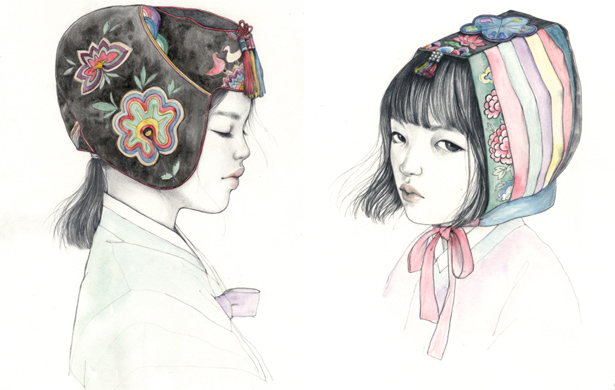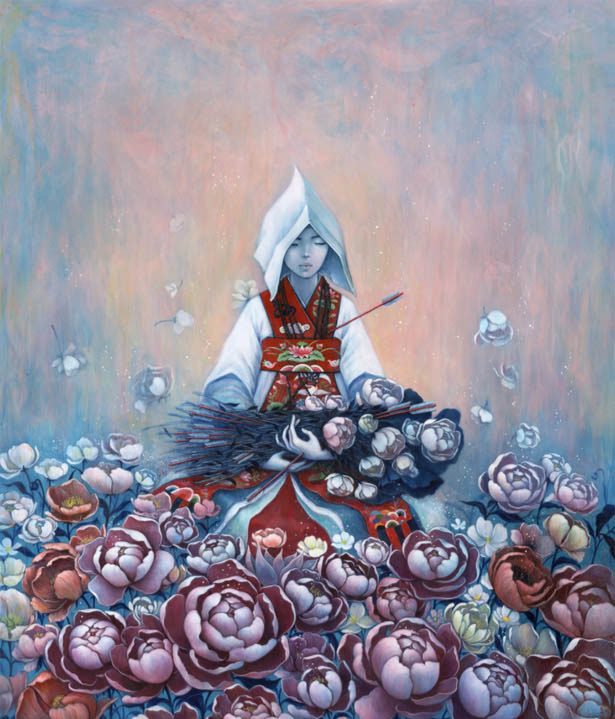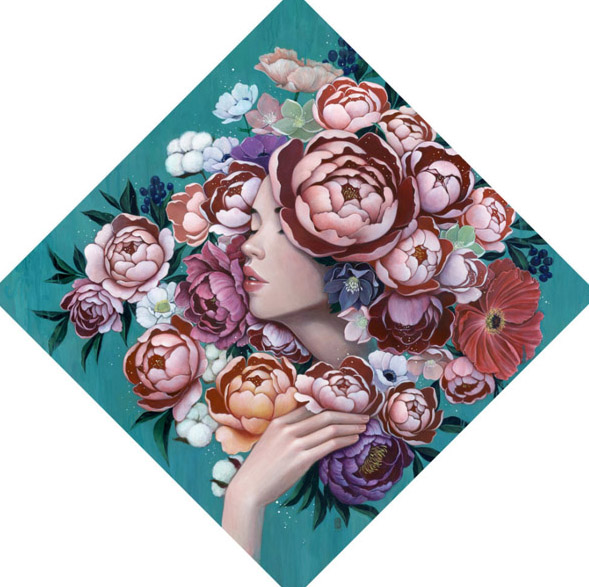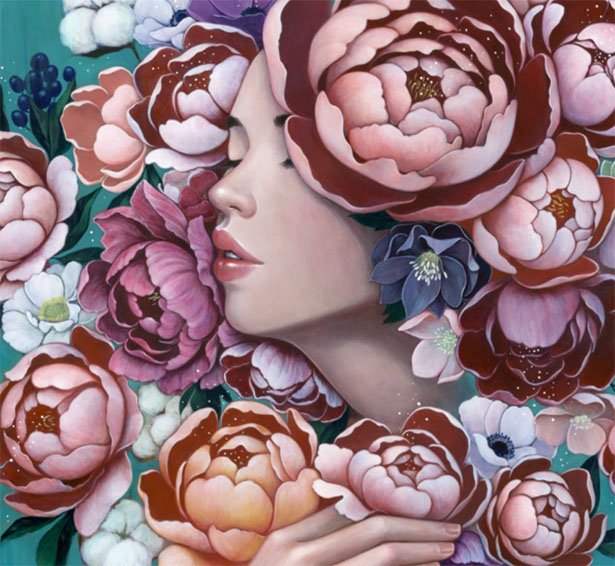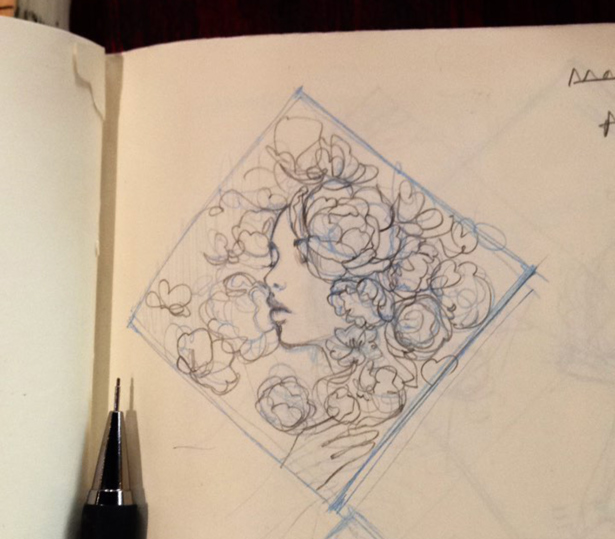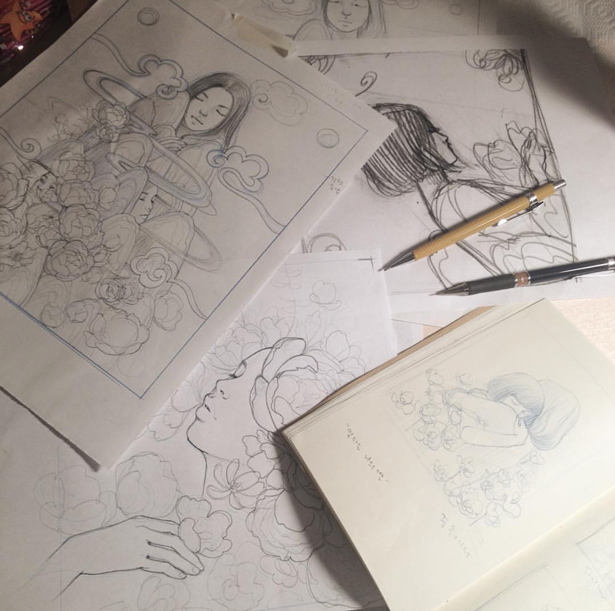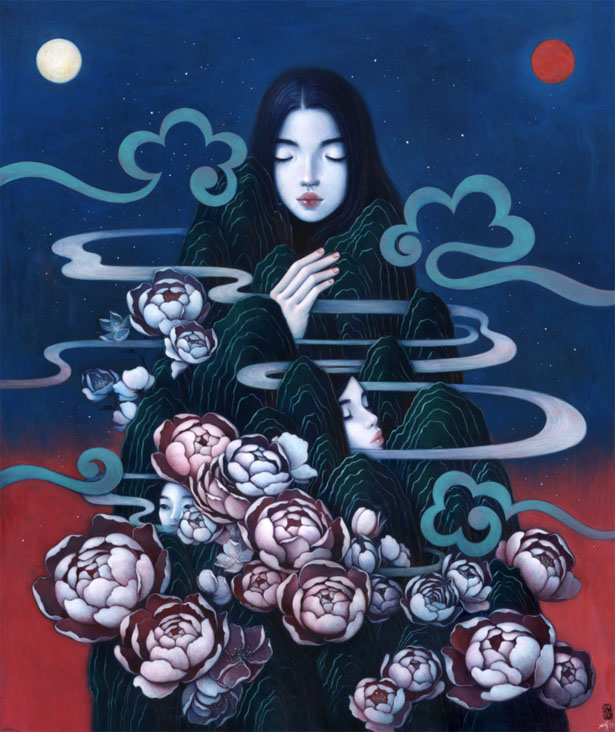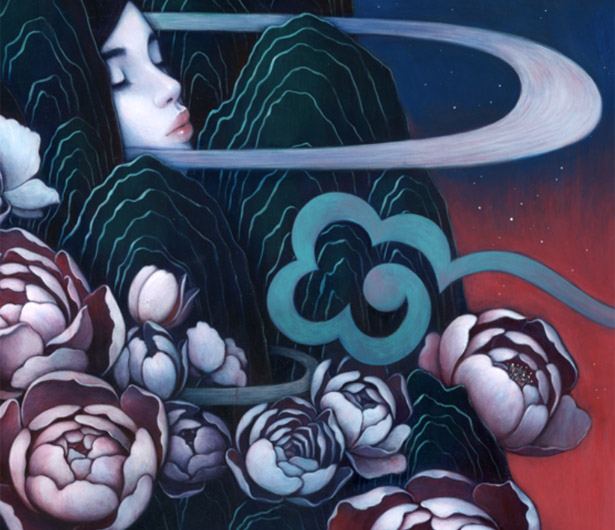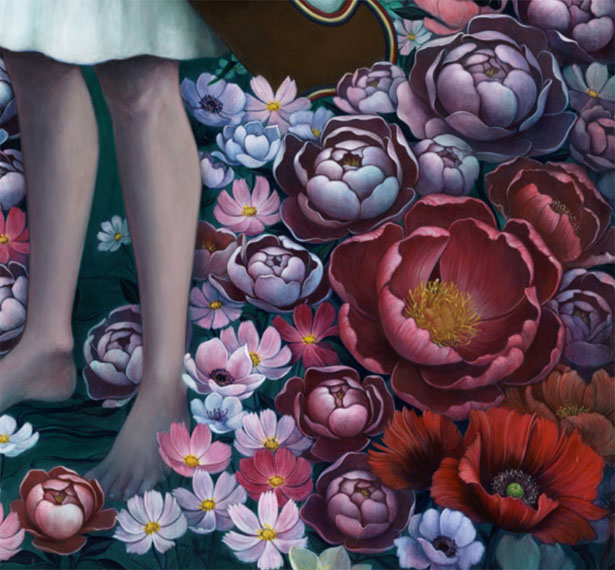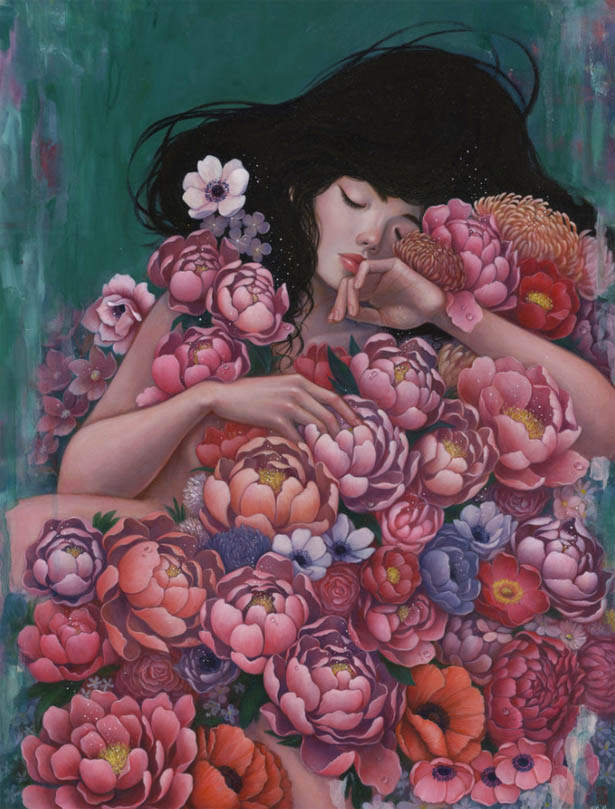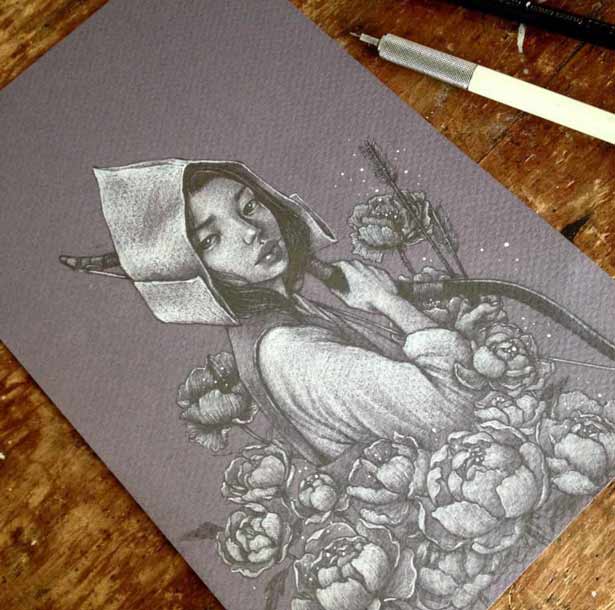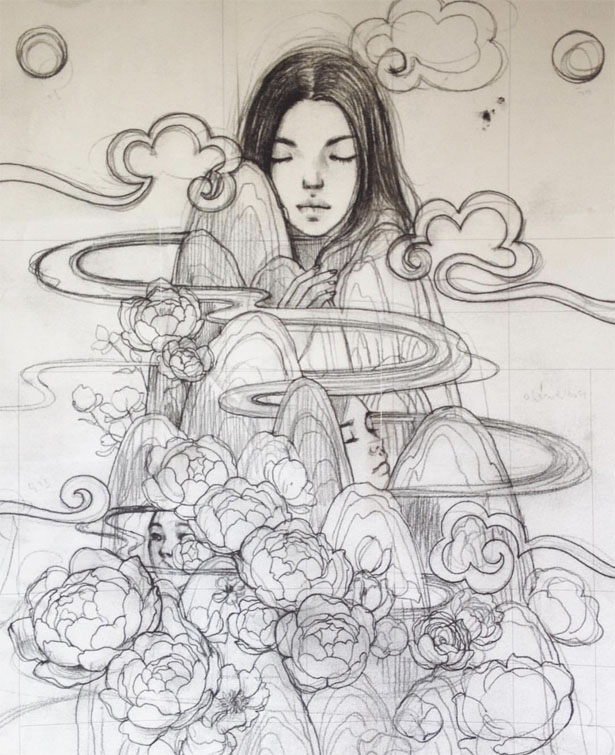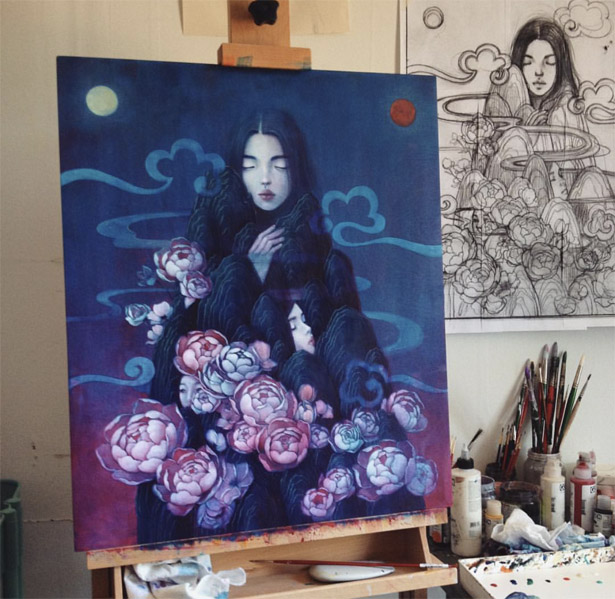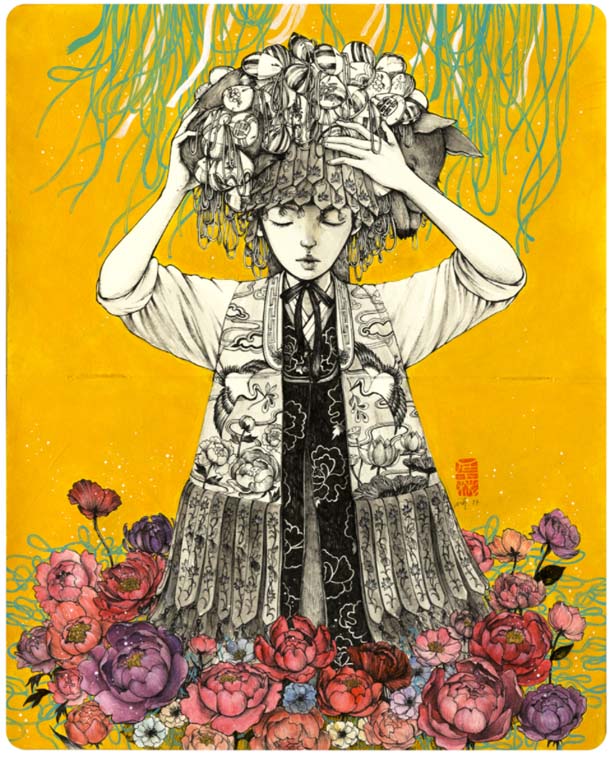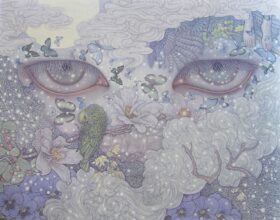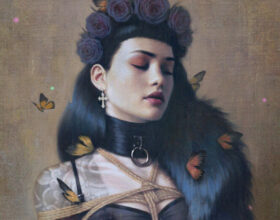The dualities that balance the paintings and drawings of Stella Im Hultberg draw the viewer into a landscape of harmony and grace. Volume and space, detail and the broader stroke, abstraction and realism blend seamlessly in fluid and organic compositions that appear effortless and uncontrived. In this landscape, the willowy women of Stella Im Hultberg, breathe softly as they slumber amongst the opening buds and heavy blooms. In that fragrant perfume, they close their eyes, still their limbs, and come gently to rest pulling a coverlet of velvety petals over their graceful bodies. Her signature flowers ground the works with their rich tones and solid forms but with symbolic meaning they become metaphors for ideas or states of being.
Throughout her bodies of work, Stella has explored female identity, but this exploration reflects a deeper understanding and maturity since the artist gave birth to her daughter. She feels this experience has brought to her, a clearer, more visible view of herself and her ideas. Now, more lucid with her intentions and directions creating new work, she is directing this focus on the representation of women in her works, and female identity as a powerful manifestation of the cyclical theme of life.
Interview conducted in conjunction with Stella Im Hultberg’s editorial in Issue 019 of Beautiful Bizarre. We hope you enjoy!
Some of your bodies of work explore your Korean heritage through traditional imagery and folklore. Can you tell us about growing up in Korea? Do you think it influenced your aesthetic from a young age?
I moved around so much that some parts of my memories from my childhood seem to have been drowned out and buried under all the new experiences I’ve had to deal with and learn as a constant “new kid”. I really have to try hard to remember something or someone from that time has to remind me. And that’s one of my recent processes to uncover those old memories, mundane or otherwise.
I grew up in Korea the first 10 years of my life, which is the longest stretch I’ve lived there. I remember hearing and reading lots of folktales imbued in rich history and tradition, a common knowledge base for many Korean people, instilled in them since childhood. Lots of fable type stories with morals and lessons to teach kids. What I hadn’t realized was how deep-seated a culture you’re raised in can be. Everything you see and hear just seeps into your pores and blood, and it becomes a part of you.
I’m not sure if Korean culture itself directly influenced my aesthetics – I am positive it has at a subliminal level, I just can’t tell how and how much it affected me. What I do know affected me and my aesthetics are probably watching a lot of Asian (Korea and Japanese mostly) animation and comic books (manga/manhwa), and the ubiquity of stationery items that are designed and illustrated (I was very shocked when I moved out of Korea and it was much less so, especially in the States).
But I’m in the process of relearning about Korea/Korean culture, which is redefining what I had previously known about it as well, swelling up a whole new appreciation for its culture and heritage.
I would like to know more about your artistic background. Did you draw and paint when you were younger? What kind of art influenced or interested you when you were younger?
I’ve always drawn and made things since I was very little. I think just growing up in Korea in the 80’s made it so easy to be surrounded by comic books (manhwa or manga ) and animation either from Korea and Japan, and so drawing comic book/cartoon characters was something I did even through teenage years. Not a lot of ‘real’ art exposure until much later in teen years. I thought I’d be a comic book artist or a designer in my early years.
I think they were pretty extensive about color theories and art classes when I was a kid in Korea. I also begged my mom for some art classes, so I had learned a few basic drawing techniques.
I also remember there was a big set of (western) art history books in the bookshelf as a kid. I’m not even sure why we had them, because I never saw anyone else in my family look at them. I would peruse all the books from time to time, admiring all the paintings from different eras in history.
When I saw Kandinsky, Picasso, and later Warhol and Basquiat, they just blew my mind. I couldn’t believe there was art like that. I know it’s funny being that I’m not that “modern art” in my personal works, but that was the first opening into the idea of “creating” art. Later when I lived in Korea again as a teen, I got to go see Warhol at a museum near my high school. I had to cut class to see it but it was such a memorable exhibit.
You studied Industrial Design and worked as a product designer before moving into fine art painting and drawing. What interested you about Industrial Design? Do you think your training has influenced your art? Did you find NYC a culture shock when you moved there? Can you describe a pivotal moment in your art career and briefly trace your artistic journey for us up to now?
When I started college, I was a bit lost as far as life direction goes. I didn’t know what I really wanted to do so I began my freshman year without a major – “Undeclared”. I took an architecture drafting class to see if I should transfer to another school for architectural program, and I accidentally stumbled upon the industrial design department. I had heard of industrial design but had no idea exactly what it entailed. It piqued my interest immediately – model making, doing research for user/human psychology and life styles, learning about materials, and, of course, drawing – it had everything I was interested in at the time (even now).
The program at my university was for a Bachelor of Science degree, so in some ways it was more technical than artistic, so as time went by, I found myself pushing for more artistic side whenever we had a project. During and after school, I worked for a furniture design company and a toy company, which seemed to allow a bit more creative leeway for me personally.
I’m not sure if being a designer really influenced my art. I personally cannot tell, especially since I feel like I use a different part of my brain for art (probably the right side) than for design (probably the left).
I grew up in Seoul, Hong Kong, and Taipei, which are insane cities in their own rights, so moving to NYC wasn’t a big culture shock at all. For me, a big culture shock was when I first moved to California! The desert climate, driving culture, and everything about LA, I had a really hard time getting used to for years!
I fell into the art world in a very serendipitous way. I had just moved to NYC, freelancing as a toy designer (my last full time job in California). I started posting some drawings in my spare time on my blog at the time (LiveJournal), toying with the idea of potentially illustrating children’s books in the future. I was then contacted by a gallery (no longer around) in LA back then to be in a group show sponsored by Vice Magazine. I was not ready at all to be showing at galleries but I thought it’d be fun. This was in 2005; a lot of new galleries were opening up specifically in the LA area. It was a very good time to be a new artist.
Then Andrew Hosner at Thinkspace Gallery contacted me after that show, and offered me a monthly spot on their back wall for introducing new artists for me to put a painting or two each month. That grew to some group shows, and later bigger shows. This led to other opportunities in other galleries and cities. I work with Thinkspace Gallery (Andrew, Shawn and LC) to this day, it’s been just incredibly lucky to have been able to work with them and the crew all these years.
I would describe you work as ethereal, serene and still, and very quiet. It is so quiet that I can almost hear it whisper to me. In more recent bodies of work the women often appear to be sleeping or in a dreamlike state, which I find interesting because life as the mother of a young child is oftimes anything but serene and still. Where do you think this stillness comes from? Is it from within, or do you find serenity through these images?
Thank you for describing my work that way – I haven’t intended for them to come off a certain way. There are certain moods or emotions I do try to fuse into my work but normally serenity or stillness is not my priority. Maybe it’s something I’m hoping for in my life, something I naturally gravitate toward.
But I have heard some people tell me that the world in my work seem very quiet. I think, especially in this body of works, the idea of a quiet resilience or strength has been in the back of my mind – inner strength hiding in the quiet exterior.
The women who seem to be sleeping or dreaming has been more frequent in recent years – it had been a while since I had painted eyes until this show. It’s probably because of my own mother who has been unconscious for the past 2 years. Thinking of her and where her mind must be.
The female takes center stage in your artwork. Can you trace the development of your exploration of female identity through your body of work, particularly in relation to before and after motherhood? I know from my research that this has impacted your life, as a mother of a young daughter, and as a daughter yourself. How much of the persona of your women comes from within and what you have immediately experienced? What has becoming a mother brought to your art?
When I first started in art, female figures were not necessarily anything of a certain identity. I was so used to drawing female characters growing up, and it was the most natural form of expression for me.
But it did take on a new meaning for me after having a kid, and coincidentally having my mom lose her consciousness right around when my child turned 2.
I’m not sure if I can explain this the right way – to me, there was something so interesting about the whole Mother-Daughter cycle. I’m sure all combination of parent-child connection have special meaning but personally something about going through the same birthing process as my own mother must have with me really struck a chord in me – and my daughter who may or may not go through a similar experience later on in her life. But I think I was more interested in the whole cyclical theme of life, in a biological/organic sense, and female identity was a big manifestation of that – mothers as providers of life cycle.
There’s a saying in Korea, that the strongest beings are mothers. It’s the epitome of the concept of “soft outside, strong inside”. A lot of our mothers may look very gentle and weak on the outside, but they’re all lions and tigers when it comes to matters of their children. I wanted to show, through female figures, that even the weakest looking beings have strength within. A quiet strength and resilience.
Becoming a mother, for me, personally, has broadened my understanding of others. I have come to be able to understand and accept other people’s choices in life much more flexibly than I used to before the kid. I may not necessarily agree with them, but I at least can imagine and see why they see things the way they do. This, in turn, made my own view of myself and my ideas just a tiny bit clearer and more visible to myself. Often times, I feel like we’re all living our lives trying to learn more about our own selves as much as other people. And us being ourselves often blind us to what we’re doing or missing. Now I feel somewhat more lucid with my intentions and directions when I create new work.
Flowers are a constant in your artworks, be it drawing or painting. From what I have read they can have symbolic meaning or become metaphors for ideas or states of being in your work. Can you talk a little bit more about what flowers you use, how you use them and what they mean in your various bodies of work, and what they add to your work aesthetically?
Flowers embody a lot of different facets of ephemerality to me. On a personal note, I remember, as a kid, not completely understanding why my mom would marvel at them all the time, to a point of obsession, and now they remind me of my mom as I do something similar when I come upon some beautiful or strange flowers. They’re a personal conduit for me to connect with my mom (with whom I cannot physically communicate due to her unconsciousness), as well as a reminder of how transient our lives and youth are.
For this body of works in Mago (and for the pieces in my “Hollow Resonance” solo show from 2016), I tried to make the flowers look a bit more rigid and sturdier compared to my older works (mostly done in ink). For my last year’s show, my very personal wishful hopes that wherever my mom’s unconscious self was wandering would be somewhere where she’d be youthful forever, her old happy, healthy self.
This year, I tried to carry that over a bit in pieces that aren’t necessarily related to such personal wishes.
There are only a few flowers that I have actively thought out their meanings – lotus is a part of my mother’s name, peonies her favorite, and cosmos (in The Archer) are a huge reminder of my childhood in Korea. I like to put poppies here and there for a bit of contrast – poppies seem to have a bit edgier and more alien quality to them compared to other flowers that seem more demure.
You have a very finely attuned sense of balance and rhythm in your compositions. How do you achieve that balance and develop that rhythm? Would you attribute it in any way to your training in Industrial Design or your Korean heritage?
I am not sure if that’s entirely true or agreeable but I appreciate you seeing it that way. It’s not something I logically plan out to do but there are certain visual proportions and compositions I’m usually drawn to. Most of them are instinctually composed, according to what feels right to me.
One of the concepts I love about Korean art (or other Eastern Asian art philosophies) is the importance of the “negative space” or emptiness. What the western art called the background was simple a part of the whole painting to balance out the overall composition. What you didn’t paint was just as important as what you did – I love this concept so much, and I really try to keep it in mind even at just a conceptual level.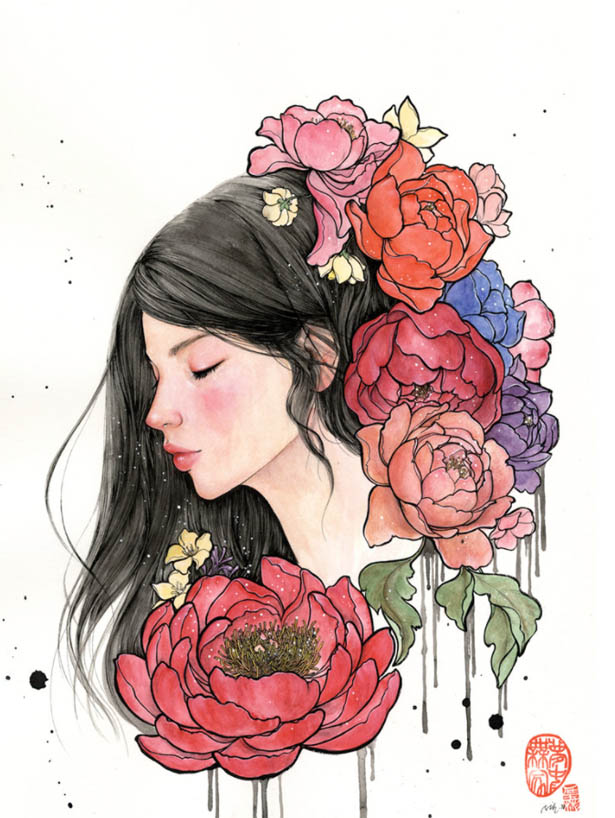
You like to switch between mediums, even including sculpture. What unique potential, effects and qualities do each of the mediums you use offer you? Do you have a preference for one over another?
Sculpture is something I always want to further pursue but often times don’t have much room in my life for, time-wise or physically. Sculpture is so fascinating because it creates a new image depending on its surroundings – lighting, background, even sound can make a different experience in looking at sculpture – like installation art.
Painting – acrylic for now – really offers a creation of an entire world, albeit in a finite space, and all the layers you can pile on offer so many possibilities of varying depths. Watercolors or inks are so amazing in ways that cannot be quite predicted. They’re alive in their own way. I love the spontaneity and translucency.
Drawing, to me, feels like such a fundamental form of expression. It’s the most immediate and freeing in a lot of ways, as well as rudimentary and limited (which is not always a bad thing).
Could you describe your artistic process when creating a body of work? What part of the process do you find most challenging? What part do you find most rewarding? Does creativity come easily for you? Do you do life studies as preparation for your artworks and do you have a particular model/s? How has the way you approach and organise your art making changed since becoming a mother?
I don’t have a very set routine for my process. A lot of them happen organically and by happenstance, even.
Usually I’ll have a very vague an idea fleeting around in the back of my head, which usually is an umbrella consisting of many different facets and strands of the same idea. I’ll try to branch them into different themes and develop them into thumbnails and sketches. I don’t necessarily force all the works to fit into one neat theme, and sometimes I’ll go a bit off tangent on some pieces. Most of the time, I will make many little renditions of sketches, scan and enlarge them and make more detailed sketches, until I have it almost planned out. After that, the final sketches are scanned and transferred onto the final surface, and are painted or drawn… for a loooong time thereafter. Sometimes I do studies first before the final, just to see what medium works best.
I am not sure exactly what it means for creativity to come easily or not, to be honest. I just roll with the ideas that pop up in my head. I have a long list of ideas I want to realize but just don’t have enough time. Life studies or models are something I want to do eventually, but a lot of my ideas come before I’m that prepared. Often times, if needed, I end up looking for photo references similar to what I’ve sketched already. Sometimes I’m inspired by certain photos of friends or relatives and will use that as an idea reference.
Motherhood has definitely gotten me more buttoned up about the way I work. I used to paint a lot more “organically”, meaning I didn’t plan a lot ahead and let things happen and change along the way. With a kid to care for all the time (and I only have one!), I have to really plan ahead and think through before putting that paint on the canvas.
You have just exhibited a new body of work with Spoke. ‘Mago’ combines influences from your Korean heritage through traditional imagery and folklore with notions about motherhood. Did you find producing these works a profound and moving experience because they explore such deeply felt and rooted parts of your being?
There was a longer time to prepare for the show, which means more ideas and influences to intertwine during those times. I had influences from Korean culture and mythology, and also from the idea of “mother” (the more conceptual idea of mother, not necessarily about moms), but before all this happened was the beginning of a very chaotic era in the US, starting with the presidential election.
I wouldn’t say painting these pieces were necessarily so profound or moving, but what I encountered in preparing for the pieces, what I have read about and researched gave me a deep resonation. I feel like I had just started to understand why we had to learn history in school (which I didn’t love as a kid). It was a lot of complex feelings.
Stella Im Hultberg Social Media Accounts
Website | Facebook | Instagram | Twitter
Related Articles
Read articles written by Beautiful Bizarre Online Author Marie Larkin



